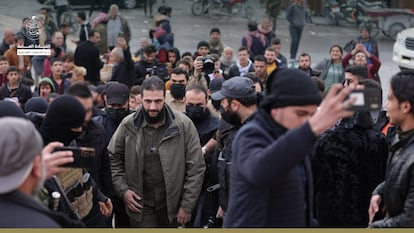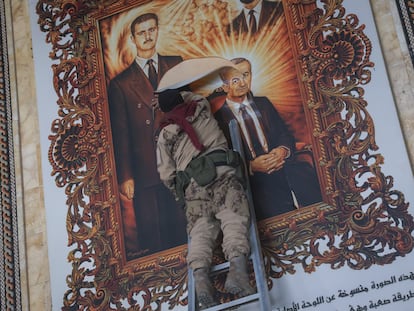The factions that overthrew Assad in Syria: Who they are and why they are a difficult fit
The Syrian National Council, the main opposition organization supported by Turkey, and Hay’at Tahrir al-Sham, the fundamentalist group leading the offensive, are the predominant actors on which a possible transition period will fall

While the muzzles of rifles from Aleppo to Damascus celebrate the final victory over the Syrian regime of Bashar al-Assad, the political trench is already in the foreground, which will decide the future government of the Arab country after more than half a century of iron-clad dictatorship. One of the names that has been most mentioned in the last week beyond the battlefield is that of Hadi al-Bahra, a 65-year-old Damascene at the head of the Syrian National Coalition (SNC), the main alliance of opposition and revolutionary forces, born in the heat of the anti-government revolts of March 2011. Last Sunday, after the surrender of the army and the flight of Assad to Moscow, Al-Bahra set two objectives for this new political path: an 18-month transition period and a new Constitution drafted within six months.
How all this will be achieved remains to be seen, provided that hostilities give the country a respite. The great challenge is to bring together at the same table all the actors who have a stake in the future model of government in Syria. And that means being able to sit down with the representatives of the main armed groups that have overthrown the Assad dictatorship: Hay’at Tahrir al-Sham (HTS) and the Syrian National Army (SNA). Although they have coordinated with each other to carry out the offensive, the suspicion and confrontation of other past periods still exists. As Al-Bahra recently told Reuters, the two groups have had “limited” joint planning and agreed to “cooperate and not clash with each other.”
Since its creation in November 2012 in Doha, the SNC has served as a political umbrella for opposition groups, both secular and religious, that have tried to offer a democratic alternative to the regime. But before Al-Bahra there were other leaders and times that were not so victorious. The first to preside over this coalition was the Islamic scholar Moaz al-Khatib. He did not last even a year. He left because, among other things, he began to discern the interference of countries such as Qatar and Saudi Arabia. Moreover, weapons always defeated a possible negotiated solution. After Khatib came George Sabra, Ahmad Jarba, and Khaled Khoja, among many others.
Soon, this amalgam of formations, representing the majority of the country’s religious faiths, gave rise, with the support of the West, to the so-called Syrian Interim Government (SIG), with Ghassan Hito as prime minister and the Free Syrian Army (FSA), the military pillar of the revolution, as its Armed Forces. It is this executive body, headed today by the 60-year-old Syrian Turkmen Abdurrahman Mustafa, which is now called upon to take over the management of the liberated zones.
It is a task that has already been carried out in the northwest of the country thanks in large part to the support of Turkey, a fundamental base of operations for the political opposition. The offensives launched by Ankara in 2016 and 2018 against the terrorist group Islamic State (ISIS), first, and later the Kurdish militias, opened a new scenario for the rebel forces. The FSA was swallowed up within a new alliance of insurgent groups — around 40 militias of different stripes — under the name of the Syrian National Army (SNA), which spearheaded the operation to overthrow Assad. Although this armed alliance should answer to the interim opposition body and its Department of Defense, the mix of groups makes total harmony difficult.
South of the zone of influence of this political and military apparatus, with its clear support from neighboring Turkey, the fundamentalist group HTS, commanded by the Syrian Abu Mohammad al-Julani, has forged its military and political growth through its control of the territory of the province of Idlib. It is there that Al-Julani — included, like his organization, on the terrorist lists of the United States and the United Nations — has managed the lives of around four million people, many of them internally displaced, through the Syrian Salvation Government, born in November 2017 as a sort of state within the state, already fragmented by the war. This administration would be divided into two: a Shura Council, a consultative body emanating from the Islamic tradition, and the executive. In a recent interview with a reporter from the U.S. network CNN, on the verge of the fall of Damascus, Al-Julani spoke of creating a government based on institutions and a “council elected by the people.”
To succeed, the HTS project has to marry with that of the Syrian Interim Government supported by Ankara — Turkey also classifies Al-Julani’s group as a terrorist organization. And there has not always been chemistry between the two. In one of his first appearances before the media, in 2013, Al-Julani, a former ally of Al Qaeda, delegitimized the work of the Syrian opposition that was trying to end the war, in a possible dialogue with the regime through what became known as the Geneva conferences. “They do not represent the people who sacrificed and shed blood,” said Al-Julani at the time.
But the Syrian political puzzle contains many pieces. To the northeast of the territory that the insurgent forces of both sides have managed to wrest from the regime is the Autonomous Administration of North and East Syria (AANES), the de facto government of the Syrian region with a Kurdish majority — it has maintained cooperation with the Assad regime — and which is now co-chaired by Ilham Ehmed and Mansur Selum. At the head of the AANES security apparatus are the Syrian Democratic Forces (SDF), an alliance of militiamen supported and trained by the United States to combat ISIS. It is the SDF that still controls the vast internment camps for relatives of the jihadist group, among which there are still hundreds of European citizens.
The stability of the country and its political unity depend largely on the stance toward this region adopted by the militias supported by Ankara under the command of the Syrian Interim Government. The forecasts are not encouraging: on Sunday, the president of this body, Prime Minister Abdurrahman Mustafa, reported through his account on the social network X the capture of Manbij, a strategic stronghold in northern Syria until now in Kurdish hands. “We proudly support our heroic forces,” said Mustafa, “and we ask them to complete the liberation of every inch of our land and to make the aspirations of freedom and dignity of our people a reality.”
Sign up for our weekly newsletter to get more English-language news coverage from EL PAÍS USA Edition
Tu suscripción se está usando en otro dispositivo
¿Quieres añadir otro usuario a tu suscripción?
Si continúas leyendo en este dispositivo, no se podrá leer en el otro.
FlechaTu suscripción se está usando en otro dispositivo y solo puedes acceder a EL PAÍS desde un dispositivo a la vez.
Si quieres compartir tu cuenta, cambia tu suscripción a la modalidad Premium, así podrás añadir otro usuario. Cada uno accederá con su propia cuenta de email, lo que os permitirá personalizar vuestra experiencia en EL PAÍS.
¿Tienes una suscripción de empresa? Accede aquí para contratar más cuentas.
En el caso de no saber quién está usando tu cuenta, te recomendamos cambiar tu contraseña aquí.
Si decides continuar compartiendo tu cuenta, este mensaje se mostrará en tu dispositivo y en el de la otra persona que está usando tu cuenta de forma indefinida, afectando a tu experiencia de lectura. Puedes consultar aquí los términos y condiciones de la suscripción digital.
More information
Archived In
Últimas noticias
Daytime, headphones, no booze involved: How a generation is saying ‘no’ to club parties
Millennia-old Yuracaré language resists extinction through 900 speakers and a new dictionary
Susan Boyle prepares a comeback just as Timothée Chalamet sings her praises
Trump suspends green card visa lottery after shooting at Brown University
Most viewed
- Christian Louboutin: ‘Young people don’t want to be like their parents. And if their parents wear sneakers, they’re going to look for something else’
- Cartels in Mexico take a leap forward with narco-drones: ‘It is criminal groups that are leading the innovation race’
- Liset Menéndez de la Prida, neuroscientist: ‘It’s not normal to constantly seek pleasure; it’s important to be bored, to be calm’
- ‘El Limones’ and the growing union disguise of Mexican organized crime
- US sanctions against jailed cartel leader ‘El Marro’ highlight Mexico’s lack of control over its prisons










































